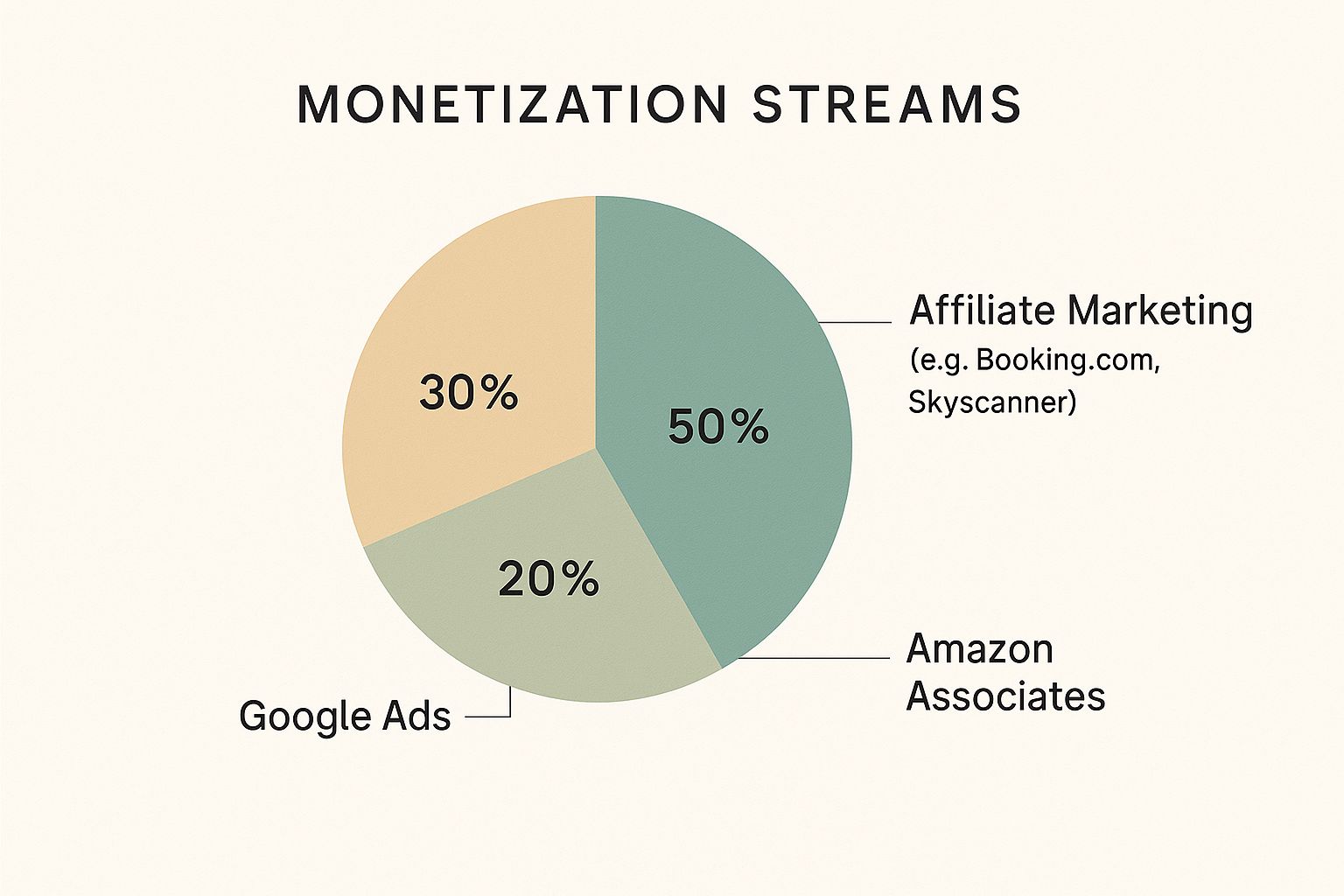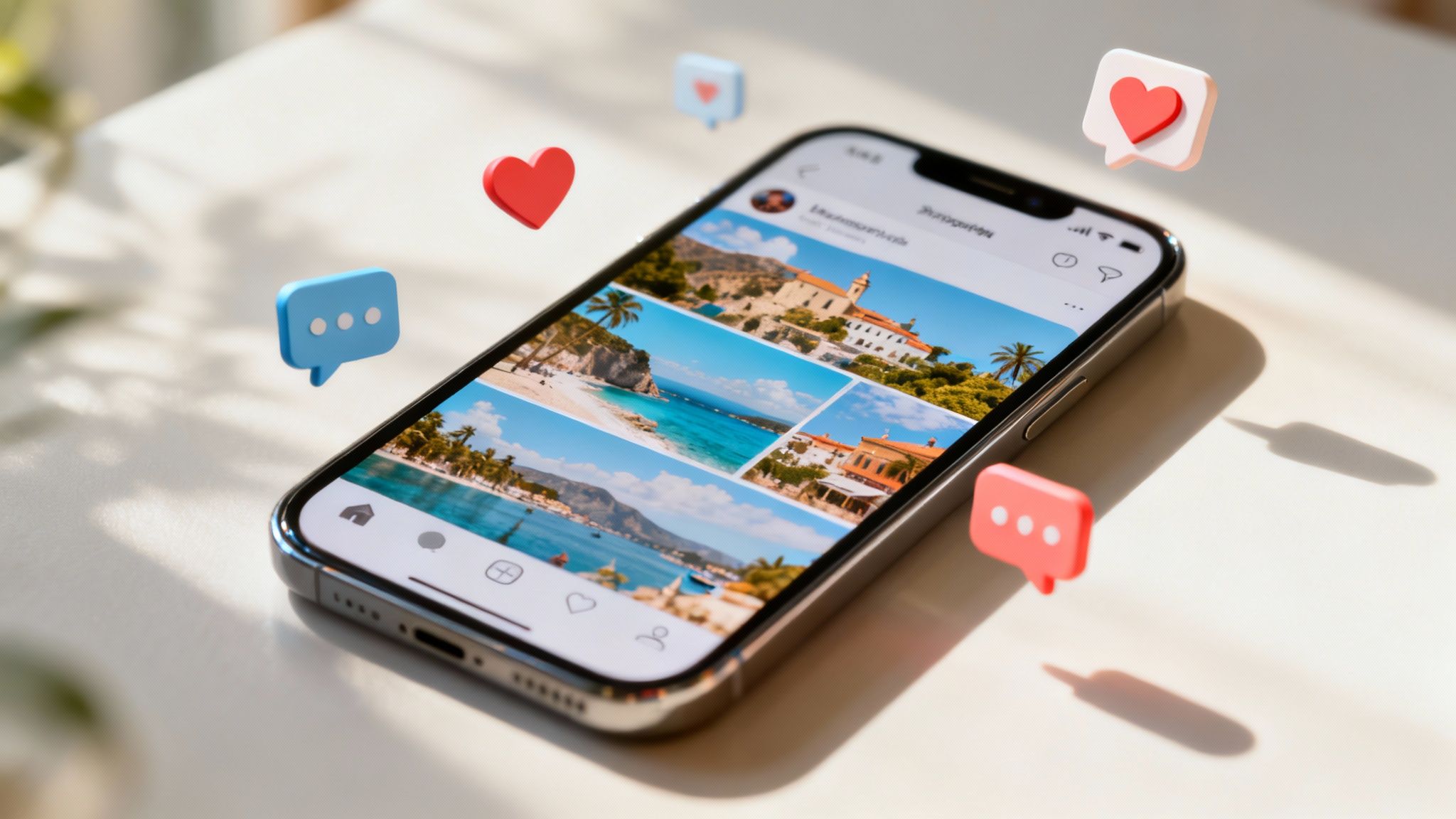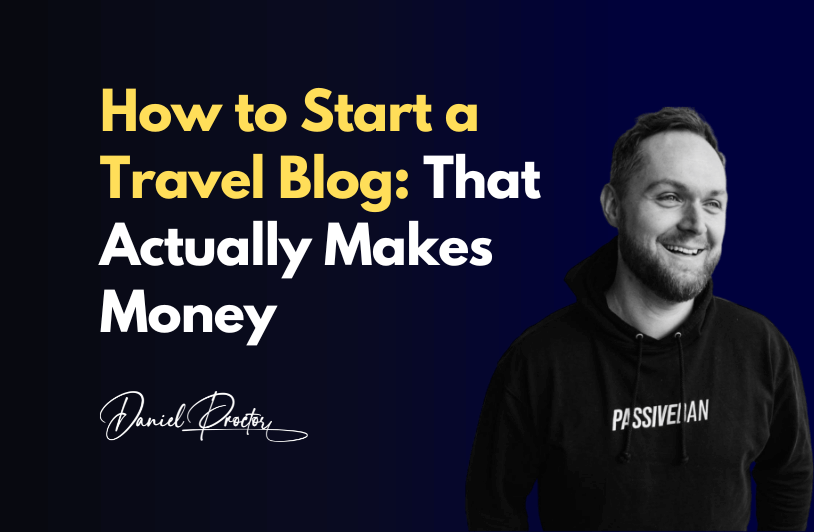So, you’re thinking about starting a travel blog. That’s the first real step—just deciding to jump in. Getting the basics up and running is faster than you might think. It really comes down to finding your corner of the travel world, grabbing a domain name, sorting out hosting, and firing up WordPress. You can honestly get the bones of your new blog live in just a few hours.
Laying The Groundwork For Your Travel Blog
Before you can post that first story about a hidden beach or a bustling city market, you’ve got to build a solid foundation. These early decisions are what will make or break your blog down the road. It’s like planning your itinerary before you even pack your bags. A successful blog isn’t just about good writing; it’s about building a brand from scratch, and that starts right here.

Jumping into travel blogging means you’re entering a massive and growing space. There are over 600 million blogs online, and travel is a huge piece of that pie. In fact, on major platforms like WordPress, roughly 10% of blogs are all about travel. That’s not a reason to be intimidated—it’s proof that there’s a huge, hungry audience out there waiting for what you have to say.
Find Your Unique Travel Niche
This is probably the single most important decision you’ll make. A generic “I go everywhere” blog is tough to get off the ground because you’re competing with absolutely everyone. It’s much smarter to zero in on a specific angle you’re genuinely passionate about. When you focus, you attract a loyal crew of readers and make it way easier for Google to figure out what you’re all about.
Need some ideas to get the wheels turning?
- Solo Female Travel: You could focus on safety, destination guides, and stories of empowerment for women hitting the road alone.
- Budget Backpacking in Southeast Asia: Think content all about stretching your dollar, finding dirt-cheap guesthouses, and navigating the region like a pro.
- Luxury Travel for Couples: Your blog could be the go-to for reviews of high-end resorts, incredible dining, and romantic escapes.
- Adventure Travel: This could be all about hiking, scuba diving, rock climbing, or anything else that gets the adrenaline pumping.
Your niche isn’t a life sentence—you can always broaden your scope later. But starting with a laser focus is the key to breaking through the noise. To really dig into this, we have a guide that breaks down https://danielproctor.com/how-to-find-your-niche/ and helps you pinpoint a topic you can truly own.
Before we move on, let’s pull these initial steps into a quick checklist. It helps to see everything in one place.
Travel Blog Launch Checklist
| Action Step | Key Consideration | Why It Matters for Growth |
|---|---|---|
| Choose Your Niche | Passion + Profitability | A focused niche attracts a dedicated audience and makes SEO easier. |
| Pick a Domain Name | Short, Memorable, Brandable | Your domain is your online address. Make it easy for people to find you. |
| Select Reliable Hosting | Speed, Uptime, Support | Slow hosting kills user experience and hurts your search rankings. |
| Install WordPress | Ease of Use & Flexibility | It’s the industry standard for a reason. Powerful and customizable. |
| Choose a Theme | Mobile-Responsive & Clean | Most readers will be on their phones. Your site must look good on mobile. |
This table covers the bare essentials to get you from idea to a live website. Nail these, and you’re building on solid ground.
Select a Memorable Domain and Reliable Hosting
Your domain name is your blog’s address on the internet. Keep it short, make it memorable, and for the love of all that is holy, make it easy to spell. Ideally, it’ll hint at your niche or your brand. While a “.com” is still king, don’t sweat it if you have to explore other options because your first choice is taken.
Once you have a name, you need a place for your blog to live—that’s web hosting. Don’t just grab the cheapest deal you can find. I’ve seen so many new bloggers make this mistake. Unreliable hosting means your site will be slow or, even worse, go down completely. This frustrates visitors and tells Google not to bother sending people your way. Look for providers with a reputation for solid customer support and great uptime.
Key Takeaway: Your domain is your brand identity and your hosting is its foundation. Investing a little more in reliable hosting from the start saves you countless headaches down the road.
Set Up WordPress and Choose Your Theme
Got your domain and hosting? Great. Now it’s time to install WordPress. Most hosts I’ve used make this ridiculously easy with a “one-click install” button. WordPress is the gold standard for bloggers—it’s powerful, incredibly flexible, and has a massive community you can turn to for help. If you want a deeper dive into the nuts and bolts of setting up a blog from scratch, this complete beginner’s guide to starting a blog is a fantastic resource.
Last but not least, you’ll pick a theme. This is what controls how your blog looks and feels. My advice? Start with something clean, professional, and mobile-responsive. Your site absolutely has to look great and be easy to use on a phone, because that’s where most of your readers will be. A good user experience keeps people on your site longer and makes them want to come back.
Creating Content That Connects and Converts
Alright, you’ve got the technical bits sorted. Now for the fun part—the heart and soul of your travel blog: the content. This is where a simple website becomes a go-to resource that people find, love, and keep coming back to.
Look, great content isn’t just about posting your travel diary online. It’s about solving real problems for your readers, building that crucial layer of trust, and—let’s be honest—setting yourself up to actually make some money from this thing.

The goal is to become the answer to someone’s late-night Google search. Think about it. They’re frantically typing in “how to pack for two weeks in a carry-on” or “is [local tour company] a scam?” Your article should be the one that pops up and saves the day.
Crafting Value-Driven Content That Sells
Here’s a secret: value-driven content that converts sales isn’t about a hard sell. It’s the opposite. It’s about providing so much genuine value that your readers see you as a trusted friend. Once you have that trust, they’ll happily take your recommendations.
Focus on formats that directly answer their questions and build that credibility.
A few types of posts have proven to be absolute workhorses for travel blogs:
- How-To Guides: These are your bread and butter. Think “How to Navigate the Tokyo Metro Without Crying” or “A 10-Day Road Trip Through Iceland on a Budget.” They offer clear, step-by-step solutions to a specific problem.
- Tips and Tricks: These are incredibly shareable and give your readers quick, satisfying wins. Posts like “15 Travel Hacks That Actually Work” or “10 Tips for Taking Better iPhone Photos” always do well.
- Review-Style Content: This is where you build serious trust and drive affiliate sales. Honest, detailed reviews of hotels, travel gear, or tours are pure gold.
And the data doesn’t lie. Online reviews are a huge deal, with 75% of travelers saying they’re extremely important when booking. What’s more, 68% are more likely to book after reading real, detailed reviews from people who’ve actually been there. This is a massive opportunity to build credibility right out of the gate. For a deeper dive, check out this report on travel statistics and trends.
Leveraging Affiliate Marketing Through Your Content
Affiliate marketing feels completely natural for travel bloggers because you’re already recommending stuff you love. The trick is to weave these recommendations into your value-driven content so they feel like a genuine tip, not a sales pitch.
For example, when you’re reviewing a hiking backpack, don’t just list the specs. Talk about how it felt after a 10-mile trek, show what you managed to cram inside, and explain why it was worth every penny. That real-world story is what convinces someone to click your link.
Popular Travel Affiliate Programs
- Booking.com & Agoda: No-brainers for recommending hotels, guesthouses, or that cool apartment you stayed in.
- GetYourGuide & Viator: Perfect for linking to tours, activities, and museum tickets.
- Skyscanner: Ideal for any post that touches on finding cheap flights or planning logistics.
- SafetyWing: My go-to for recommending travel insurance, especially for fellow digital nomads and long-term travelers.
And don’t sleep on Amazon Associates. The list of travel-related products you can link to is practically endless.
Amazon Travel Niche Product Ideas
- Electronics: Universal power adapters, portable chargers, noise-canceling headphones, travel drones, waterproof phone cases.
- Luggage & Organizers: That perfect carry-on, packing cubes (a lifesaver!), toiletry bags, luggage scales, travel wallets.
- Comfort Items: Travel pillows, eye masks, reusable water bottles, quick-dry towels.
- Safety Gear: Money belts, RFID-blocking wallets, basic first-aid kits, personal safety alarms.
Weave affiliate links for these products into relevant posts—like a “What’s In My Camera Bag?” article or a “Ultimate Southeast Asia Packing List”—and you create a natural pathway for passive income.
Growing Beyond Content: Sponsorships and Ads
Once your blog starts picking up steam and you’ve built a community, other doors will open. The two big ones are direct sponsorships and display ads.
Google Ads can perform well since the travel sector pays high commissions for booking tours, trips, and tickets. When advertisers pay more, you earn more per ad view.
Better yet, once you have an engaged community reading your email updates and following you on social, you become attractive to brands. This is how you get sponsors for your travel blog. A tourism board might sponsor a trip, or a gear company might pay you to feature their product. This all comes back to one thing: having a loyal audience that trusts your opinion, which all starts with creating genuinely helpful content.
Smart Monetization Strategies for Travel Bloggers
Okay, so you’ve started publishing some killer content. Now for the fun part: making sure your blog can actually fund your adventures. Thinking about monetization isn’t just about earning cash; it’s about building a real, sustainable business that lets you keep exploring and sharing your stories.
And honestly, the timing couldn’t be better. The online travel booking scene is exploding right now. It was valued at a massive $512.5 billion in 2023 and is projected to hit $1.26 trillion by 2032. Thanks to everyone being glued to their smartphones and a huge rise in solo travel, more people than ever are online looking for the exact kind of real-world advice you can offer. You can see more on these online travel booking trends for yourself.
This chart breaks down a smart way to approach your blog’s income, showing how affiliate marketing usually takes the lead, supported by other key streams.

As you can see, mixing it up is key. You never want to put all your eggs in one basket. A diversified strategy gives your blog a much more stable financial footing.
Tapping into Travel Affiliate Programs
For most travel bloggers, affiliate marketing is the bread and butter. And for good reason. You get to earn a commission just by recommending the hotels, tours, and gear you already use and love. It’s a natural fit. The only rule? Be authentic. Only promote stuff you can genuinely stand behind.
To get you started, here are a few of the big players that are super effective for travel content:
- Booking.com: A total powerhouse for accommodation. Perfect for linking to that amazing boutique hotel or budget-friendly hostel you stayed at.
- Skyscanner: An absolute go-to for finding cheap flights. It’s incredibly easy to weave this into posts about planning trips or traveling on a budget.
- GetYourGuide: Ideal for recommending tours, day trips, and attraction tickets. This adds a ton of value to your destination guides.
- SafetyWing: Sells travel medical insurance, which is a non-negotiable for many travelers, especially if you’re writing for digital nomads or long-term backpackers.
The real secret to making sales isn’t just dropping links everywhere. It’s about explaining why you’re recommending something. Did that hotel have the perfect location for exploring the city on foot? Was that tour guide a local legend with incredible stories? This kind of context builds trust and gives people a reason to act on your advice.
If you want to go deeper on this, I’ve got a whole guide on affiliate marketing for bloggers that breaks down these strategies even more.
To help you get started, here’s a quick look at some of the top affiliate programs in the travel space.
Comparing Top Travel Affiliate Programs
Choosing the right affiliate partners is crucial. You want programs that align with your content and offer fair terms. This table breaks down some of the most popular networks to help you decide where to focus your efforts.
| Affiliate Program | Best For | Commission Rate | Cookie Duration |
|---|---|---|---|
| Booking.com | Hotel & accommodation reviews | 25-40% of their commission | Session-based |
| GetYourGuide | Destination guides & tour reviews | 8% and up | 31 days |
| Amazon Associates | Packing lists & gear reviews | 1-10% (Varies by category) | 24 hours |
| SafetyWing | Digital nomads & long-term travel | 10% (recurring) | 365 days |
Ultimately, the best approach is to join a few that fit your niche. Don’t spread yourself too thin, but having a couple of solid options gives you flexibility when creating different types of content.
The Endless Potential of Amazon Associates
Beyond the big travel platforms, the Amazon Associates program is a goldmine. It gives you access to a massive catalog of physical products that every traveler needs. The beauty of it is the sheer variety—you can find and recommend items that are a perfect fit for your specific audience.
Just think about the gear you can’t travel without. Your readers want those tried-and-true recommendations.
This could be anything from:
- Electronics: The noise-canceling headphones that save your sanity on long-haul flights, a reliable portable power bank, or a universal travel adapter.
- Luggage and Organizers: Your favorite carry-on suitcase, those game-changing packing cubes, or a durable toiletry bag that’s survived years on the road.
- Photography Gear: The exact camera and lens setup you use, your go-to travel tripod, or the drone you use for those epic aerial shots.
- Comfort Essentials: That travel pillow that actually works, a water filter bottle for staying hydrated safely, or a set of quick-dry towels.
Review posts work incredibly well here. A detailed article like “What’s In My Camera Bag” or “My Ultimate Packing List for Southeast Asia” is a super natural way to include affiliate links to the products you actually use and trust.
Maximizing Revenue with Google Ads
While affiliate marketing relies on your reader taking action, display ads offer a more passive way to earn. By using a service like Google AdSense, you get paid just for having ads on your site. The travel niche is great for this because advertisers are willing to pay top dollar to reach people planning trips, which means higher ad revenue for you.
When you’re just starting out, the income will be pretty small. Don’t get discouraged. As your traffic grows, ad revenue can become a surprisingly steady and significant piece of your monthly income.
Expert Insight: Don’t plaster your brand-new blog with ads. It looks spammy and can turn readers off. Your first job is to build an audience by creating amazing content. Once you have consistent traffic, you can start adding ads in a way that doesn’t ruin the user experience.
Building a Community and Attracting Sponsors
At the end of the day, the most valuable thing you can build isn’t just a blog—it’s a loyal community. When people genuinely trust your advice, they’ll do more than just click your affiliate links. They’ll subscribe to your newsletter, follow you on social media, and engage with your content.
An email list is your direct line to your most loyal readers. Sending out regular updates with exclusive tips or behind-the-scenes stories keeps them connected and coming back for more.
Once you have that engaged audience, you’ll start attracting attention from brands. A tourism board might offer to pay you to visit and write about their region, or a gear company could sponsor a series of videos featuring their products. This is where the real magic happens, bringing your travel blogging journey full circle.
Building a Community Your Readers Will Love
Look, a successful travel blog isn’t just a digital scrapbook of your trips. It’s a community. It’s a hub for people who get just as excited about a hidden alleyway cafe or a sunrise hike as you do.
When you shift from just writing content to actually building a following, everything changes. That’s the moment your passion project starts feeling like a real, sustainable brand. Your readers stop being passive visitors and become active members of your journey.

Honestly, this engaged audience is your single most valuable asset. It’s the foundation for everything—from the traffic that keeps your site alive to the big-ticket sponsorships you’ll land down the road. It all starts with making genuine connections.
Your Email List Is Your Greatest Asset
If there’s one thing I can drill into your head, it’s this: Your email list is your direct line to your most loyal fans. Forget social media algorithms that can tank your reach overnight. You own your email list. It’s the one reliable way to talk to people who’ve asked to hear from you.
Start building your list from day one. Don’t wait. Offer something genuinely useful in exchange for an email—maybe a PDF packing checklist for Southeast Asia, a mini-guide to finding the best street food in Mexico City, or access to your top travel hacking tips.
The goal isn’t just to collect emails; it’s to send regular, value-packed updates that keep people hooked. Share the real stories, the behind-the-scenes screw-ups, or early access to travel deals you’ve found. This direct connection builds a kind of trust you just can’t get anywhere else.
An engaged email list isn’t just a list of contacts; it’s a community waiting to hear your next story. Treat it with respect, provide immense value, and it will become the cornerstone of your travel blog’s success.
From Content to Sponsorships
Here’s the magic that happens when you have a dedicated community: brands start paying attention. Sponsorships are the natural next step once you’ve built that loyal following. It’s not just about your traffic numbers; it’s about having an audience that genuinely trusts what you say.
A tourism board might pay for a trip to their country. A gear company might send you their newest backpack to review. A hotel chain could offer a free stay for a feature on your blog.
These opportunities pop up because brands want access to the influence you have with your people. That genuine connection you’ve built is what makes these collaborations feel authentic—and what makes them work.
This whole progression from content creator to sponsored traveler is fueled by the community you build. It’s the ultimate reward for showing up, day after day, and serving your audience with content they can actually use and trust. Focus on your readers first. The brands will follow.
Driving Organic Traffic with Proven SEO Tactics
Look, writing great content is awesome, but it’s only half the job. If nobody finds it, what’s the point? This is where Search Engine Optimization (SEO) comes in. Think of it as the engine that works for you 24/7, bringing a steady flow of free traffic to your blog for years. It’s how you build a bridge between your articles and the people who are actively searching for what you have to say.
SEO isn’t some dark art or about trying to trick Google. It’s simply about understanding what your readers are typing into the search bar and then creating content that gives them exactly what they’re looking for. Get this right, and you’ll turn a personal travel diary into a high-traffic resource.
Understanding the Language of Your Audience
Everything in SEO starts with keyword research. This is just a fancy way of saying you need to figure out the exact phrases people use when they’re looking for travel tips. Are they searching for “things to do in Bangkok” or is it more like “Bangkok 3 day itinerary”? That small difference can be huge.
To really get anywhere, you have to nail down some actionable keyword research best practices. It’s how you find topics people are actually interested in but where the competition isn’t insane, giving your new blog a real shot at showing up on Google.
A few types of keywords you’ll want to focus on:
- Long-Tail Keywords: Instead of a super broad term like “Thailand,” go for something specific like “best street food in Chiang Mai for families.” They’re way less competitive and attract people who know exactly what they want.
- Informational Keywords: These usually start with “how to,” “what is,” or “best.” An article like “How to get from Bangkok to Koh Samui” is perfect for this. It answers a direct question and helps build your authority.
- Commercial Keywords: When you see phrases with “review” or “vs,” you know someone is close to pulling out their wallet. An article titled “Osprey Farpoint 40 vs. Nomatic Travel Pack Review” is perfectly set up for affiliate links.
On-Page SEO: Your Content Checklist
Once you’ve picked your keyword, you need to place it in a few key spots within your article. This is called on-page SEO, and it’s basically you signaling to Google what your post is all about. It’s a series of small, practical steps that make a big difference.
The goal is simple: make it dead obvious to both Google and your readers what your article covers.
Here are the key places to get right:
- Post Title (H1 Tag): Your main headline. It needs to be catchy and include your primary keyword without sounding weird or forced.
- Headings (H2s and H3s): Break up your content with subheadings. They make the post easier to read and are a great place to put your keyword or related phrases.
- URL Slug: Keep it short and sweet. Something like
yourblog.com/how-to-start-travel-blogis perfect. - Image Alt Text: This is just a simple description of your images. Use your keyword here—it helps with accessibility and can get you traffic from Google Images.
Don’t forget about site speed. A slow website is a deal-breaker for visitors and a major red flag for Google. Having fast, reliable hosting is one of the most critical technical things you can sort out from day one. You can see just how much hosting impacts performance in this detailed Rocket.net hosting review—it really drills down on why speed is so important.
Building Authority with Backlinks
Okay, the last piece of the SEO puzzle is building your blog’s authority with backlinks. A backlink is just a link from another website pointing to yours. Google sees these as “votes of confidence.” The more high-quality votes you get, the more trustworthy your blog looks.
This is definitely a long-term game, but it’s probably the most powerful way to climb to the top of the search results. The best way to get them is to create amazing content that people naturally want to share. Another solid method is guest posting—writing an article for another travel blog in your niche. You get a link back to your site, and you get your name in front of a whole new audience. It’s a win-win.
Your Top Questions About Travel Blogging, Answered
Jumping into the world of travel blogging always brings up a ton of questions. I get it. You’re wondering about everything from how you’ll actually make money to what the day-to-day grind really looks like. Let’s clear the air and tackle the most common questions head-on.
How Can a New Travel Blog Even Make Money?
Forget the myth that you need a million followers to make a dime. The key is to build multiple income streams around a smaller, highly-engaged audience that actually trusts what you have to say.
The best place to start is with value-driven content that naturally weaves in affiliate links. Think about it: a super-detailed review of the travel backpack you swear by, or a step-by-step guide on mastering a city’s subway system. These are perfect spots to link to products and services you genuinely use and love. It’s the most authentic way to build trust and earn a bit of passive income at the same time.
What are Some Decent Affiliate Programs for Travel?
The travel niche is absolutely packed with affiliate opportunities. The trick is to partner with programs that offer services your readers are already looking for. It just makes sense.
Here are a few of the heavy hitters I’d recommend looking into:
- Booking.com & Agoda: These are your bread and butter for accommodation bookings. Almost every travel post can link to a hotel, hostel, or guesthouse.
- GetYourGuide & Viator: Perfect for earning a cut from tours, cooking classes, museum tickets, and other activities you recommend in your destination guides.
- Skyscanner: My go-to for recommending a solid flight search tool.
- SafetyWing: A fantastic option for promoting travel insurance, especially if you’re writing for long-term travelers or digital nomads.
- Amazon Associates: This is an absolute powerhouse. Don’t sleep on it.
Seriously, don’t underestimate Amazon. The list of relevant travel gear is endless: packing cubes, noise-canceling headphones, universal adapters, specific camera gear, portable chargers, travel-sized toiletries… you name it. A well-put-together “Ultimate Packing List” post can easily become one of your best earners.
Once you start seeing some real traffic, you can flip the switch on display advertising. Services like Google Ads can perform incredibly well in the travel space. Advertisers pay good money for travel-related bookings, which means your ad revenue can become pretty substantial once you have a steady stream of visitors.
How Do You Land Sponsorships?
Sponsorships don’t come from just having big traffic numbers. They come from building a real community—an audience that trusts you and hangs on your every word. And that all starts with creating genuinely helpful, high-quality content that keeps them coming back for more.
The next move? Get them on an email list. This gives you a direct line to your most loyal readers. You can send them exclusive email updates, share personal stories, or offer special deals. That’s how you build a rock-solid bond.
This is what brands are really after. A tourism board might pay for your trip, or a gear company might sponsor a post because they want access to the influence you’ve built with your people. Focus on building that community first. The sponsorship opportunities will find you.

